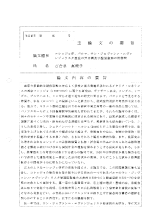- 著者
- 百合草 真理子
- 出版者
- 美学会
- 雑誌
- 美学 (ISSN:05200962)
- 巻号頁・発行日
- vol.66, no.2, pp.153, 2015-12-31 (Released:2017-05-22)
- 著者
- 百合草 真理子
- 出版者
- 美学会
- 雑誌
- 美学 (ISSN:05200962)
- 巻号頁・発行日
- vol.66, no.2, pp.25-36, 2015-12-31 (Released:2017-05-22)
From 1520 to 1524, Antonio Allegri da Correggio (1489-1534) depicted the Second Coming on the cupola in San Giovanni Evangelista in Parma. This painting has been pointed out the formal relationship to Raffael's "Transfiguration" (1518-20). Though it has been over looked its theological significance, according to St. Bede, the transfigured Christ not only prefigured his outward appearance at the Second Coming, but also related to the resurrection of Christ and the Elect. In the early 16^<th> century, especially in Italy, the Transfiguration, the Resurrection and the Ascension that implies a reference to his Second Coming were conflated by lifting Chirst off the ground. From this iconograhic tradition and the liturgical context of San Giovanni Evangelista, I consider that Correggio adopted the Transfiguration type for the Second Coming on purpose to represent the glory revealed by his resurrection. Moreover, the subjects for the western cupola and the apse, the Transition of St. John Evangelist and the Coronation of Virgin, mean that the image of Christ on the ceiling, which underscores his human body, reminded the viewer of his own resurrection that would take place in the future. Consequently, I conclude that the cupola represents Christ's nature as both God and man, in contrast to the precedent view that read only his divinity there.
- 著者
- 百合草 真理子
- 出版者
- 名古屋大学大学院文学研究科
- 雑誌
- 名古屋大学人文科学研究 (ISSN:09109803)
- 巻号頁・発行日
- vol.43-44, pp.3-17, 2016-03

